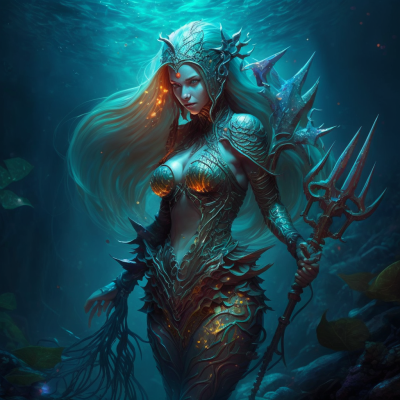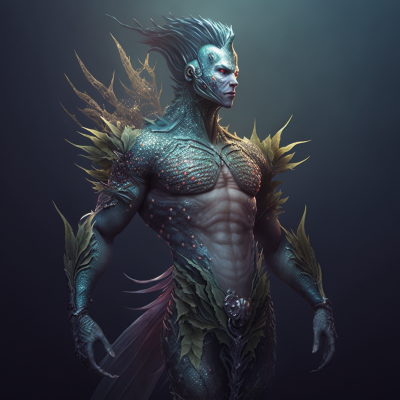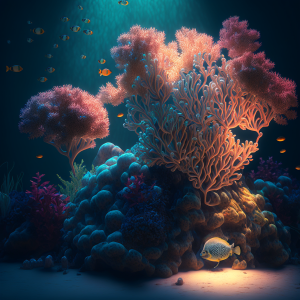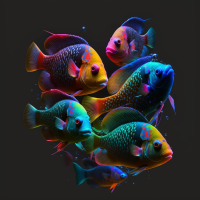Sidebar
Table of Contents
Cemlae
The Cemlae species are the first species encountered in the Kosuke Sector by the Yamatai Star Empire in YE 45. They are one of two major species found on the planet Becurn(YC-56K) III1). They were first encountered by the ISS Shiori, while investigating a waypoint for the Colonization Initiative Alliance fleet.
History
The Cemlae species are one of two species that were transplanted on the planet Becurn(YC-56K) III by the Illionites in YE 28. Their history prior to their arrival on Becurn(YC-56K) III is unknown to them2), they refer to their arrival as their “Rise in the Great Sea”. Their society has grown under the monarchy of King Zomsin Blubbian, who has encouraged the development of their subsurface cities across the Great Sea of Becurn. Ever since their arrival, they have been in constant competition and a state of war against the surface-dwelling Mocaidins who were also transplanted onto the planet.
The war between these two species has dominated Cemlae society, their industrial complex has been geared toward it since their rise. In YE 32, the Cemlae developed thermonuclear weapons and launched a vicious attack against the Mocaidins on the island of Serithious, which resulted in the death of nearly two million Mocaidins. The following year in YE 33, the Mocaidins retaliated with a thermonuclear weapon of their own which resulted in a widespread radiological disaster which through dispersion on the currents in the southern region of the Great Sea, resulted in the death of almost three million Cemlae. The escalation between these two peoples has increased over time with major skirmishes well into YE 40. Most of the Cemlae's knowledge comes from what they refer to as the Pearl of Becurn.3)
In YE 45, the ISS Shiori encountered the Cemlae for the first time 4).
Physiology
The physiology of the Cemlae in terms of appearance is a hybridization of a Human with a fish-like (cartilage appendages like Chondrichthyes) tail and fin structure from the waist down. In scientific terms, however, the Cemlae species appears to be a naturally evolved species of human that has adapted to life beneath the surface of the ocean. They are sexually dimorphic, with male and female genders represented. Notably, they resemble merfolk from mythology.
| Cemlae | |
|---|---|
| Cemlae Female | |
 |
|
| Cemlae Male | |
 |
|
| Scientific Name | Homo cemlae |
| Type | Humanoid |
Highlights
Some facts about Cemlae physiology.
- The Cemlae have adapted gills to allow them to breathe under the water.
- The Cemlae can breathe outside of the water so long as their gill structures remain wet.
- The Cemlae have a natural symbiosis with a bioluminescent bacteria.
Common Physiology
The Cemlae share a common physiology with humans, but are unique to their own species with the following common attributes.
| Common Physical Attributes | |
|---|---|
| Hands and Fingers | Opposable thumbs, four fingers, five knuckles. Small suction cup adaptation for gripping. |
| Teeth | Ominivore denture |
| Pelage | Head, Hair as well as mixed fin structures. |
| Ears | Small ears. |
| Eyes | Normal shape |
| Height | 160cm to 180cm |
| Weight | 60kg-80kg |
| Common Body Pigmentation | |
|---|---|
| Skin (Scales) | Scale patterns are common with blue, pink, black, and gold. |
| Hair | (Common) Blonde, Black, White, Blue, and Pink |
| Eye | (Common) Gold, Black, Red, and Blue. |
Unique Physiology
The Cemlae are magnificent humanoids with extravagant fish-like features such as fins and a scale-armored epidermis. They breathe through the use of gills similar to fish, and their lower half consists of a large tail and fin structure which along with the fin structures help them control their position within the water column.
- Echolocation - They can produce short clicks and pulses of sound that help them detect things around them. Most Cemlae can use this ability up to 500m.
- Bioluminescence - A symbiotic bioluminescent bacteria live on the scales of the Cemlae, they produce a vibrant illumination that helps blend Cemlae into the coral reefs.
- Powerful Tail Fin - The muscles in the midsection of Cemlae are highly developed, making the lower tail fin an extremely powerful appendage that can help them propel through the water quickly.
- Four-gill structures - Scale-protected gills are present on the left and right side of the neck, as well as the left and right side of the hips.
Diet
The Cemlae eat several different types of algae, small fish, crustaceans, and echinoderms found in the Great Sea of Becurn.
Environment
 The Cemlae species thrive in the coral-filled shallows of the Great Sea of Becurn. Optimal conditions for the species are as follows:
The Cemlae species thrive in the coral-filled shallows of the Great Sea of Becurn. Optimal conditions for the species are as follows:
- Salinity Range - 32ppt to 42ppt
- Water Temperature - 26 to 31 degrees Celsius
- Dissolved Oxygen - 10mg/L to 5mg/L
- Optimal Depth - 50m to 1000m
- Crush Depth - 5600m
Their post-industrial society has created opulent cities beneath the waves. However industrial stresses have impacted their environment, but their struggle with the Mocaidins has taken priority. The radiation damage from the war, both from Mocaidin attacks and their own R&D has had a very negative impact on the coral in some regions.
Cemlae cities and settlements tend to blend in with the natural rock found in the seabed as well as the coral.
Life Cycle
The Cemlae are sexually dimorphic, and their genitals are arranged similarly to humans with some differences. The male's penis is retractable and is hidden behind an armored layer of scales found in about the same position as it is found on a human. The female's vagina however is positioned in a more frontal position in the same region, and also has an armored layer of scales. The scales provide protection for sexual organs when they are not in use. The Cemlae can mate year around but prefer to venture to breed ground settlements that are like resorts to engage in mating. The female becomes pregnant when her eggs are fertilized and the child remains in the female for roughly six months before it is birthed.
- Life Expectancy - 77 to 80 years.
- Adulthood - begins at 18 years of age.
- Gestation Period - 6 months.
In terms of knowledge regarding their potential lifespan, the Cemlae are unsure. They remember very little from the world they had come from nor have any understanding of things beyond their world. As of YE 45 the eldest Cemlae on Becurn III is 35 years old.
Culture
The Cemlae have an interesting culture that has developed around their war with the Mocaidins.
Clothing
The Cemlae do not wear clothing, rather they embrace the beauty of their natural scales. The more brightly colored and lavishly arranged the scales are the more beautiful the Cemlae is considered to be. The scales also hide and 'armor' things such as the female's breasts and genitals as well as the male's genitals which keeps them covered in terms of decency.
They often wear shells, or pieces of coral crafted into jewelry.
Some Favorite Foods
Some prized foods of the Cemlae are listed here.
Language
The primary language of the Cemlae uses their natural echolocation abilities. A series of pulses and clicks that can travel over distances under the water. Most are able to Trade (language) which is shared with the Mocaidins.
Naming
Cemlae naming tends to be complex, due to their primary language. However, when translated to Trade (language) their naming becomes a little more clear. Most Cemlae are named for natural features or structures of coral. For example, King Zomsin Blubbian, the leader of the Cemlae is named for the Zomsin peak of the Blubbian coral formation that serves as the altar for their Pearl of Becurn.
Politics
The Cemlae species are an Absolute Monarchy under the rule of King Zomsin Blubbian. The King has centered his rule under the advisement of the Pearl of Becurn, an alien AI that they have declared their god. The Peal of Becurn specifically is very outspoken about the war with the Mocaidin. The continual state of war and suspicion is part of the master plan of the alien faction which transplanted them on Becurn 5), who use the conflict as a source of entertainment.
Technology
The Cemlae species are at a post-industrial revolution stage of development. Their most recent discovery of thermonuclear weapons and power have helped shape and modernize their society. They are non-spacefaring, although obviously not native to Becurn.6)
Economy
The economy of the Cemlae people is based on a metal-filled type of small cockle shell which is stamped with the seal of King Zomsin Blubbian. This serves as a currency called Boju. The Cemlae are self-sustaining and in general, do not engage in trade outside of their own nation due to the only other species on Becurn being their enemy.
OOC Notes
Andrew created this article on 2023/01/07 17:49.
- The Cemlae are a NPC Species and are not for player use.
- This NPC species will be posted to the NTSE following the first Campaign in Hinomaru Sunrises II.
This article was approve by Wes on 2023/01/04.7) Artwork was done in Midjourney by Andrew.
| species | |
|---|---|
| Species Category | alien |
| Nanomachines | Unknown |
| Symbiotics | Unknown |
| Pharmaceuticals | Unknown |
Page Tools
Terms of Service - Privacy Policy


